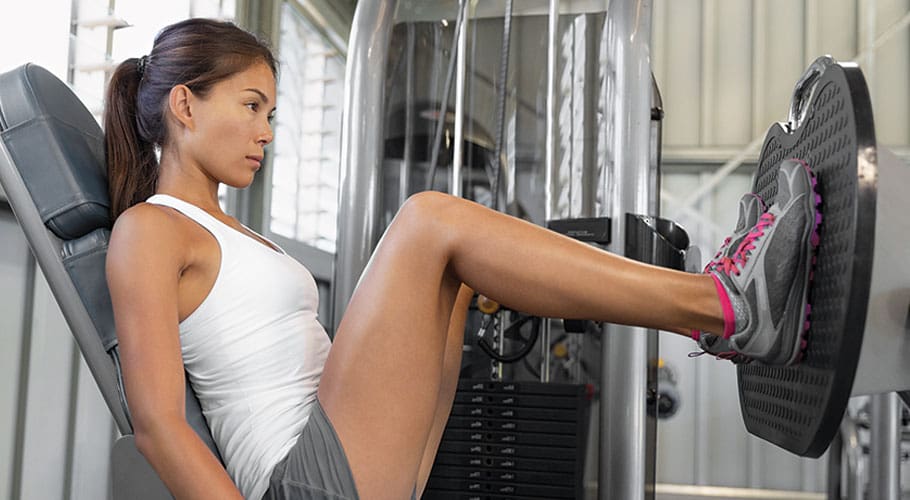Costco Connection | July | For Your Health | Don’t go weak in the knees

© Maridav / stock.adobe.com
Don’t go weak in the knees
Preventing knee issues and keeping you on the move
by Suja Natarajan
The knees are the largest and one of the most stressed joints in the body, making them vulnerable to injury. One of the most common ailments for Americans of all ages is knee pain; according to a 2018 article in American Family Physician, knee pain affects 25% of American adults.
Common knee problems include torn cartilage, sprains, fractures and underlying medical conditions, such as rheumatoid arthritis or diabetes. Symptoms can range from mild discomfort to swelling, weakness, stiffness or an inability to straighten the knee.
Here are a few ideas to keep your knees in top shape.
Strengthen muscles
The quadriceps and the hamstrings are two muscle groups that support and stabilize the knee joint. Strengthening these muscle groups improves knee mobility and keeps them flexible. Strong quadriceps can help take pressure and shock off the knee joints. Weight-bearing exercises [see “Keep them fit”] are crucial.
Increase range of motion
Full range of motion (ROM) allows the joint to bend, rotate or extend. ROM exercises stimulate the joint to produce synovial fluid, natural lubrication that maintains the balance and smooth movement of the joints, says Dr. Mark Slabaugh, an orthopedic sports medicine surgeon in Baltimore. Gentle, persistent stretching will strengthen and restore the motion of the knee.
Good posture
Proper shoulder, back, knee and leg posture can prevent pressure on the joints and the supporting muscles. Sitting on your knees, crossing your legs and slouching forward puts pressure on the knee and can damage the cartilage. “When we slouch or stoop, our center of gravity shifts, which places more stress on our hip and knees,” says Dr. William Leone, an orthopedic surgeon in Fort Lauderdale, Florida.

© puhhha / stock.adobe.com; Yingko / stock.adobe.com
Eat right
Shore up your knees with essential joint-healthy nutrients. “Calcium and vitamin D are critical components for good bone health,” says Leone. Dairy, leafy greens, canned sardines, salmon, tuna, mackerel, mushrooms and foods fortified with calcium, vitamin C and vitamin D contain great bone-boosting nutrients. Ask your doctor about supplements if you don’t get enough bone nutrition from food.
Stay hydrated
As 70% to 80% of joint cartilage consists of water, lack of hydration causes less lubrication in the joints, in turn causing joint pain. Drinking more water improves the production of synovial fluid, reduces inflammation, supports circulation and maintains cartilage’s shock-absorbing properties.
Ease the load
A healthy body weight lessens stress on your joints. “Your knees experience an additional 4 pounds of pressure for each extra pound of body weight,” says Dr. Bert Mandelbaum, a sports medicine specialist and orthopedic surgeon in Los Angeles. A 2018 study published in Arthritis Care & Research indicates that losing more weight results in pain relief and improved function.
Avoid injuries
Warm up before any workout and cool down afterward. According to the American Academy of Orthopaedic Surgeons, gentle stretching after strengthening exercises can help ease pain and boost muscle flexibility. Change the intensity of physical activity gradually and stop exercising if you feel any pain. Wear appropriate shoes for better alignment and balance of the knee joint, and incorporate rest periods into training regimens.
Adopt a healthy lifestyle early to strengthen your joints to minimize the risk of injury and reduce the stress on your knees.
Treating injury
Rest, over-the-counter pain relievers, compression and elevation may help alleviate minor knee symptoms. However, traumatic events, such as feeling a pop with a deep squat, twisting the knee during a workout, catching or locking (inability to move the joint) are serious injuries that warrant a visit to an ortho surgeon. “If the knee remains swollen longer than a few days, patients should also seek medical advice,” says orthopedic surgeon Mark Slabaugh.—SN
Keep them fit
Strengthening and stretching exercises increase flexibility and lower the risk of pain and injury. Leg lifts, hamstring curls, wall squats, single-leg dips, step exercises, seated knee extension, standing knee flexion, and calf and heel raises are fantastic knee-strengthening exercises to add to your workout routine. Low-impact activities such as swimming, cycling, elliptical training, rowing and hiking can also improve knee flexibility and strength. Talk to your doctor about specific workouts that are good for you.—SN
Costco Connection: Healthful foods, fitness equipment , supplements, over-the-counter pain relievers and more are available in Costco warehouses and at Costco.com.
Suja Natarajan is a writer based in Virginia.



